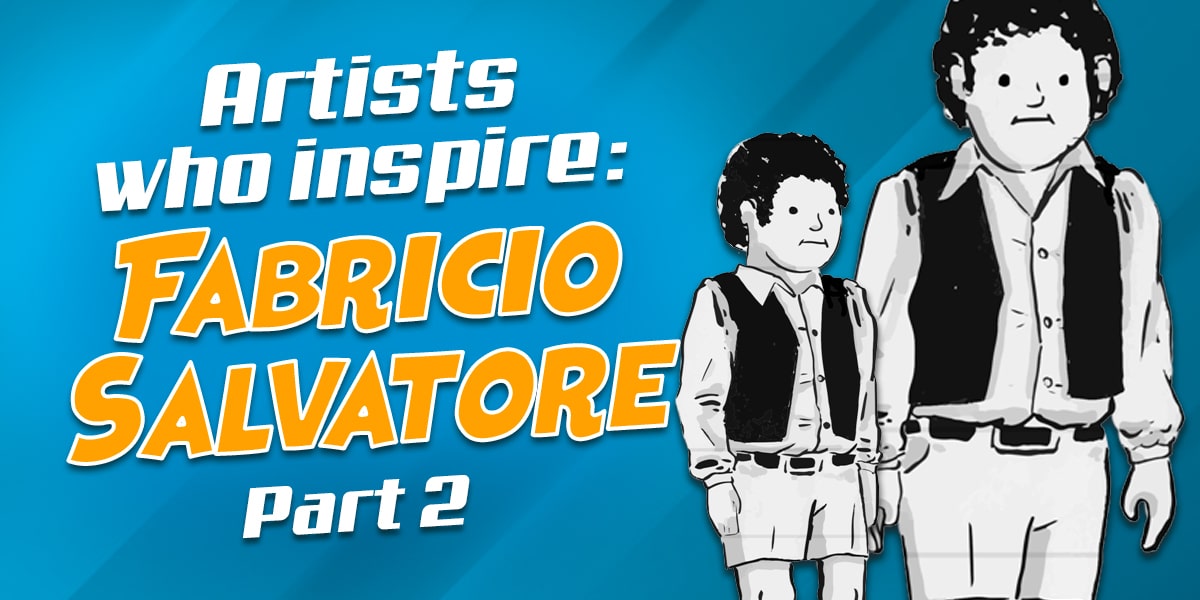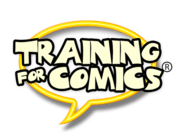Interview with Fabricio Salvatore (Part 2): Secrets, Techniques, and Recommendations from a Young Comic Master
Have you ever wondered what lies behind the panels of a graphic novel? What secrets does an artist’s creative process hold? Get ready to discover it in this second part of our fascinating interview with Fabricio Salvatore, a 24-year-old comic prodigy. We’ll delve into the intricacies of his creative process, his inspirations, and the challenges he faced while creating his first graphic novel. From his preferred tools to a list of must-read comics, Fabricio opens the doors to his artistic world. Join us on this journey to the heart of comic creation!
The Creative Odyssey: The Birth of a 120-Page Graphic Novel
When we asked Fabricio about his experience creating such an extensive comic for the first time, his answer left us speechless. What began as a challenge to his mentor, Manuel Loza, transformed into a creative adventure of epic proportions.
“The first advice he gave me was ‘don’t make a 200-page comic because you’ll end up getting tired, you’ll end up getting bored, and you’ll end up leaving it halfway through’. Wise advice,” Fabricio tells us with a mischievous smile. “I, half not believing, said ‘Oh, really? Well’ and to prove him wrong, I made a 120-page comic.”
This act of creative rebellion not only resulted in his first graphic novel, “Kaspar Hauser,” but also became a journey of self-discovery. Fabricio describes the process as “very therapeutic,” revealing how each page became a time marker in his life.

“I would draw it whenever I could. If I could draw in my room, I would draw in my room, if I could in the classroom, I would do it there. Once I was invited to a party and I had to finish a personal deadline, I went to the event with the page and drew and finished it there,” Fabricio recalls. This unwavering dedication is a testament to the passion that drives true artists.
The creation of “Kaspar Hauser” spanned three years, a period during which Fabricio experienced significant personal growth. “There are pages that I look at and I remember what moment of my life I was in and even in what geographical place I made that comic,” he reflects. This intimate connection between the artist and his work is what gives life and depth to the stories he creates.
For those who dream of embarking on their own creative adventure, Fabricio has an inspiring message: “There’s a very therapeutic aspect to doing a work that takes you two or three years because in three years, you change a lot as a person”. Want to take the leap and start your own epic project? Discover how here and begin bringing your most ambitious ideas to life.
The Artist’s Arsenal: Tools and Techniques of a Budding Master
When it comes to the tools of his trade, Fabricio adopted a decidedly traditional approach for “Kaspar Hauser”. “I did everything as analog as possible,” he explains, “because one of the objectives of this comic was precisely to learn how to make it”.

His creative process involved classic methods: drawing board, pencil sketching, and inking. However, Fabricio wasn’t afraid to experiment, using markers for shading. Although he warns about the challenges of using these instruments in extensive projects: “They’re great, but I wouldn’t use them again and I don’t recommend them for such an extensive work, because they end up wearing out and you can refill them, but they never have the same fluidity again”.
This experience led Fabricio to adapt his approach, combining traditional techniques with digital tools. “Drawing and shading in ink and marker. Then, cleaning, polishing, and error correction I did with Photoshop and ClipStudioPaint,” he explains. “Lastly, the text and speech bubbles were done entirely digitally”.
The lesson here is clear: flexibility and willingness to adapt your methods are crucial in the world of art. The combination of traditional and digital techniques can open up a world of creative possibilities. Click here to explore techniques that can revolutionize your creative process and discover how you can take your art to the next level.
Masters of the Craft: The References that Inspire Fabricio
Every great artist has their muses, and Fabricio is no exception. When we asked him about his references, three names immediately emerged: Minaverry, Manuel Loza, and Mariano Taibo.
About Minaverry, Fabricio comments: “He does a lot of what I wanted to do. He sees comics as a medium to tell strong and meaningful stories and not so much as magazines to read while you go to the bathroom”. This elevated vision of comics as a medium for artistic and social expression resonates deeply with Fabricio’s philosophy.

Manuel Loza, whom Fabricio affectionately refers to as his “sensei”, plays a crucial role in his development not only as an artist but as a human being. “Manuel taught me to be a good human being, which I think is even more important than being a good artist,” Fabricio reflects. This lesson on the importance of community and collaboration in the art world is invaluable.
Lastly, Mariano Taibo is admired by Fabricio for his “expression, a line, and a very human violence” in his stories. This ability to capture the essence of the human condition in art is something Fabricio aspires to emulate in his own work.
The influence of these artists is reflected in Fabricio’s work, demonstrating how learning and inspiration from masters can shape the unique voice of an emerging artist. Ready to find your own artistic voice? Enter here to perfect the art of visual expression and discover how you can develop your unique style by drawing inspiration from the great masters of comics.
Essential Readings: The Comics That Have Marked Fabricio
For every artist, inspiration often comes from works that have left a lasting impression on their mind and heart. Fabricio shares with us the comics that have fascinated him and that he considers essential reading for any aspiring comic creator.
“From Minaverry, Dora,” Fabricio begins. “I think that, in a few years, we’re going to start thinking of Dora as the great Argentine comic of the early 21st century”. This bold prediction underscores the impact Minaverry has had on the Argentine comic scene and on Fabricio’s own artistic vision.

From his mentor, Manuel Loza, Fabricio recommends “Almer”. He describes the work as “Many separate stories, of the same character, that hook medieval fantasy and politics, in a very beautiful way”. This fusion of genres and themes demonstrates the versatility and depth that Fabricio admires in Loza’s work.
Lastly, from Mariano Taibo, Fabricio highlights “A tu rojo ruta”. “A simple story, not very long, and very visceral,” he explains. “It was one of the comics I read and said ‘Wow, I want to make comics, I want to convey what this person conveys'”. This moment of epiphany illustrates the transformative power that a work of art can have in the life of a budding artist.
These recommendations not only offer a window into Fabricio’s influences but also provide an invaluable reading list for anyone looking to immerse themselves in the world of contemporary Argentine comics. Eager to explore new artistic horizons? Discover here how to broaden your creative horizons and find inspiration in comic masterpieces.
Challenges and Pleasures: The Ups and Downs of the Creative Process
Like every artist, Fabricio faces his own challenges and finds joy in specific aspects of his work. When we asked him about what he finds most difficult to draw, his answer was revealing.
“If we understand cost as what takes me time to do, obviously it’s architecture,” Fabricio admits. For “Kaspar Hauser”, he chose not to use modern tracing techniques, preferring a more traditional approach as part of his learning process. This decision, although challenging, demonstrates his commitment to mastering the fundamental techniques of comic art.

As for execution, Fabricio confesses that facial expressions were his biggest challenge. “Scott McCloud gave me a huge hand in understanding expressions and making the character convey through the face,” he explains. This attention to emotional details underscores the importance Fabricio places on emotional connection with his readers.
On the other hand, when it comes to what he enjoys drawing the most, Fabricio lights up when talking about uniforms and historical costumes. “One of the reasons why I was also interested in Kaspar is the setting. Those suits with socks up to the knees, the wrinkles of the pants, and the jackets with a lot of buttons, which are like cut in the middle and continue below,” he describes enthusiastically.
This passion for historical details and period fashion not only enriches his art but also adds an additional layer of authenticity to his narratives. “I draw not only to give a message but because I like it. I really like that type of clothing,” Fabricio concludes.
Fabricio’s honesty about his challenges and passions offers valuable insight into the creative process, reminding us that even the most talented artists face obstacles and find joy in the most unexpected details. Ready to face your own artistic challenges? Explore more here and discover how to overcome creative obstacles to take your art to the next level.
Lessons from a Young Master: The Path to Artistic Excellence
Our interview with Fabricio Salvatore has been a fascinating journey through the creative process of a young and passionate artist. From his bold decision to create a 120-page graphic novel as his first work, to his reflections on the tools, techniques, and challenges of the craft, Fabricio has offered us an intimate and honest view of the world of comic creation.
His words resonate with the wisdom of someone who has learned valuable lessons through direct experience. The importance of perseverance, the willingness to experiment with different techniques, and the value of learning from the masters of the medium are just some of the gems we can extract from our conversation with Fabricio.
But perhaps the most important lesson he leaves us with is the importance of passion and authenticity in art. Whether struggling with facial expressions or delighting in the details of a 19th-century uniform, Fabricio reminds us that true art is born from love for the craft and the desire to tell stories that resonate with others.
For those who dream of following in Fabricio’s footsteps and embarking on their own creative odyssey, his words offer both inspiration and a healthy dose of realism. The path may be long and challenging, but also incredibly rewarding.
We invite you to explore more about Fabricio Salvatore’s work on his social media (@fabricioposting) and, most importantly, to encourage you to take the first step in your own artistic journey. Remember, every great artist started with a simple sketch and a dream.
Are you ready to start your own adventure in the world of comics? Click here to take the first step and discover your artistic potential. The world of comics awaits you, full of infinite possibilities and stories to tell. Who knows? Maybe you’ll be the next Fabricio Salvatore, inspiring a new generation of artists with your creativity and passion.
See you in the next interview, where we’ll continue exploring the secrets and wonders of the fascinating world of comics!



